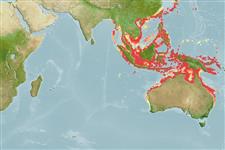>
Eupercaria/misc (Various families in series Eupercaria) >
Nemipteridae (Threadfin breams, Whiptail breams)
Etymology: Scolopsis: Name from the Greek masculine noun 'skolos' meaning 'thorn' and suffix '-opsis' (from Greek feminine n. 'opsis' meaning 'aspect', 'appearance') meaning ‘thorny appearance’ presumably referring to 'les dentelures de la préopercule, en ont aussi, et même d'épineuses, aux sous-orbitaires' mentioned by Cuvier (1814) in his designation of the genus. Name ending in -'opsis' are treated as feminine according to ICZN 1999: Article 30.1.2 (Ref. 130620).
More on author: Cuvier.
Environment: milieu / climate zone / نطاق العمق / distribution range
البيئة
بحري مرتبطة بالشعاب; نطاق العمق 2 - 50 m (Ref. 90102). Tropical; 32°N - 31°S, 90°E - 157°E (Ref. 3810)
Indo-West Pacific: eastern Indian Ocean (Andaman Sea and northwest Australia) to Papua New Guinea, north to the Ryukyu Islands, south to northeastern Australia. This species has been previously reported as Scolopsis dubiosus (a junior synonym of Scolopsis taeniopterus), or misidentified as Scolopsis temporalis.
الحجم / وزن / العمر
النضج: Lm ? range ? - ? cm
Max length : 38.0 cm TL ذكر/ مختلط الجنس; (Ref. 90102); common length : 18.0 cm SL ذكر/ مختلط الجنس; (Ref. 3810)
الأشواك الظهرية (المجموع) : 10; الأشعة الظهرية الناعمة (المجموع) : 9; شوكة شرجية: 3; أشعه شرجية لينه: 7. Head scales reaching to between anterior margin of eyes and posterior nostrils. Lower limb of preopercle scaly. Antrorse (forward-directed) suborbital spine absent. Pelvic fins long, reaching almost to level of origin of anal fin. Upper lobe of caudal fin a little longer than lower lobe. In larger specimens, lobes produced to form short filamentous extensions in larger specimens. 3 blue stripes on snout; uppermost joining eyes above nostrils. A blue stripe on preopercle behind eye. A blue chevron-shaped stripe running upwards onto opercle from below eye and bending downward towards pectoral-fin base.
Body shape (shape guide): fusiform / normal; Cross section: oval.
Occurs on sand bottoms close to reefs. Often silty habitats (Ref. 48635). Occurs solitary or in small groups. Feeds on small fishes, crustaceans, mollusks and polychaete worms (Ref. 90102). It is parasitised by the monogenean Anoplodiscus hutsonae on the pectoral fins and body surface (Ref. 124057).
Life cycle and mating behavior
النضج | التكاثر | وضع البيض | بيض | الخصوبة | Larvae
Russell, B.C., 1990. FAO Species Catalogue. Vol. 12. Nemipterid fishes of the world. (Threadfin breams, whiptail breams, monocle breams, dwarf monocle breams, and coral breams). Family Nemipteridae. An annotated and illustrated catalogue of nemipterid species known to date. FAO Fish. Synop. 125(12):149p. Rome: FAO. (Ref. 3810)
IUCN Red List Status (Ref. 130435: Version 2025-1)
استخدامات بشرية
مصائد: غير مهمة تجارياً
أدوات
تقارير خاصة
Download XML
مصادر علي الأنترنت
Estimates based on models
Preferred temperature (مرجع
123201): 24.9 - 29.1, mean 28.2 °C (based on 982 cells).
Phylogenetic diversity index (مرجع
82804): PD
50 = 0.5000 [Uniqueness, from 0.5 = low to 2.0 = high].
Bayesian length-weight: a=0.01905 (0.01045 - 0.03473), b=3.03 (2.88 - 3.18), in cm total length, based on LWR estimates for this species & Genus-body shape (Ref.
93245).
مستوى غذائي (مرجع
69278): 3.5 ±0.5 se; based on diet studies.
المرونه (مرجع
120179): وسيط, الحد الزمني الأدني لتضاعف عدد أفراد المجتمع 1.4-4.4 سنة (Preliminary K or Fecundity.).
Fishing Vulnerability (Ref.
59153): Low to moderate vulnerability (28 of 100).
🛈
Nutrients (Ref.
124155): Calcium = 46.1 [28.8, 89.1] mg/100g; Iron = 0.601 [0.298, 1.483] mg/100g; Protein = 19 [17, 21] %; Omega3 = 0.143 [0.087, 0.238] g/100g; Selenium = 32 [19, 56] μg/100g; VitaminA = 66.9 [19.2, 186.7] μg/100g; Zinc = 1.16 [0.82, 1.66] mg/100g (wet weight);
